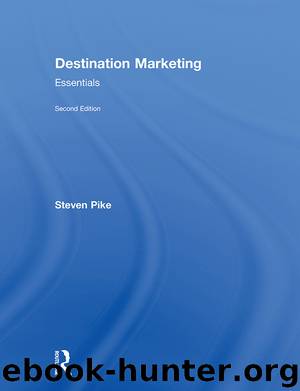Destination Marketing: Essentials by Steven Pike

Author:Steven Pike
Language: eng
Format: epub
Publisher: Swales and Willis
Published: 2016-03-18T16:00:00+00:00
Forward thinking
Marketing is as much a forward-thinking exercise about unmet consumer wants as it is about catering to current wants. Hamel and Prahalad (1989) argued the importance of devoting time to thinking about the future. They urged organisations to develop a view about the future as an ongoing project sustained by continuous debate, rather than a massive one-time effort. While it would be futile to attempt to predict the future (Drucker, 1995), it is critical that emerging megatrends, which have the potential to shape the future of the tourism industry, either positively or negatively, are explored. In examining the historical time lag from technological invention to market use and acceptance, Drucker suggested the future is already here, and that we should look to the fringes of society to observe future applications that are currently in the exploratory design stages. Everything that will be in common use in 30 years’ time already exists in some form today, being developed somewhere on the fringes of society.
There exists a rich resource of views offered by futurists, whose research explores trends in mainstream society as well as developments occurring on the fringes. A sample of futurists’ thoughts in 2015, which might have tourism implications, is provided in Table 8.5. Other well-known futurists include: John Naisbitt (www.naisbitt.com), Faith Popcorn (www.faithpopcorn.com), Alvin Toffler (www.alvintoffler.net), Ray Kurzweil (www.kurzweilai.net) and Nick Bostrom (www.nickbostrom.com). Unfortunately, tourism as a topic has received little attention from futurists (Cole and Razak, 2009). Most notable to date have been the books of tourism futurologist Ian Yeoman (2008, 2012). Yeoman was formerly a scenario planner for Visit Scotland. Tourism academics are canvassed on the most important issues facing the global tourism each year by Professor David Edgell Sr., of East Carolina University. Using the TRInet listserve of over 2,000 tourism academics, Edgell posts a summary of the top 10 trends that year. Table 8.6 summarises the most important issues, which represent potential opportunities and threats, for 2014 and 2015.
Scenario thinking
Scenario planning was developed by Wack (1985) and promoted by Schwartz (1991) as a structured way of thinking about the future. In the form of carefully constructed plots, scenario thinking is underpinned by: (1) adopting the long view; (2) outside-inside thinking; and (3) drawing from multiple perspectives. In a world of continuous-discontinuous change (continuous but differing types of change rather than incremental adjustments) the approach is ideal for DMOs to tap the wider community of stakeholders’ creativity and entrepreneurship thinking to help make sense of the future. Little has been reported about scenario thinking for DMOs in the tourism literature to date. Formica and Kothari (2008) outlined their use of scenario thinking with stakeholders of the tourism industry in the US tri-state area of Pennsylvania, New Jersey and Delaware, to identify forces likely to drive change in the industry over the next five years. Adopting a longer-term view, Yeoman (2012) described a range of scenarios for global tourism in the year 2050. As suggested in Chapter 7, scenario thinking is particularly useful in developing disaster response strategies.
Download
This site does not store any files on its server. We only index and link to content provided by other sites. Please contact the content providers to delete copyright contents if any and email us, we'll remove relevant links or contents immediately.
| Advertising | Consumer Behavior |
| Customer Service | Marketing |
| Public Relations | Sales & Selling |
| Search Engine Optimization |
Influence: The Psychology of Persuasion by Robert B. Cialdini(4716)
The Miracle Morning by Hal Elrod(4640)
The Hacking of the American Mind by Robert H. Lustig(4319)
Pre-Suasion: A Revolutionary Way to Influence and Persuade by Robert Cialdini(4153)
Unlabel: Selling You Without Selling Out by Marc Ecko(3591)
Ogilvy on Advertising by David Ogilvy(3517)
Hidden Persuasion: 33 psychological influence techniques in advertising by Marc Andrews & Matthijs van Leeuwen & Rick van Baaren(3476)
Purple Cow by Seth Godin(3143)
Who Can You Trust? by Rachel Botsman(3089)
Kick Ass in College: Highest Rated "How to Study in College" Book | 77 Ninja Study Skills Tips and Career Strategies | Motivational for College Students: A Guerrilla Guide to College Success by Fox Gunnar(3077)
The Marketing Plan Handbook: Develop Big-Picture Marketing Plans for Pennies on the Dollar by Robert W. Bly(2978)
This Is Marketing by Seth Godin(2974)
I Live in the Future & Here's How It Works by Nick Bilton(2938)
The Power of Broke by Daymond John(2900)
Building a StoryBrand by Donald Miller(2843)
The Tipping Point by Malcolm Gladwell(2829)
The 46 Rules of Genius: An Innovator's Guide to Creativity (Voices That Matter) by Marty Neumeier(2799)
Draw to Win: A Crash Course on How to Lead, Sell, and Innovate With Your Visual Mind by Dan Roam(2740)
Market Wizards by Jack D. Schwager(2645)
